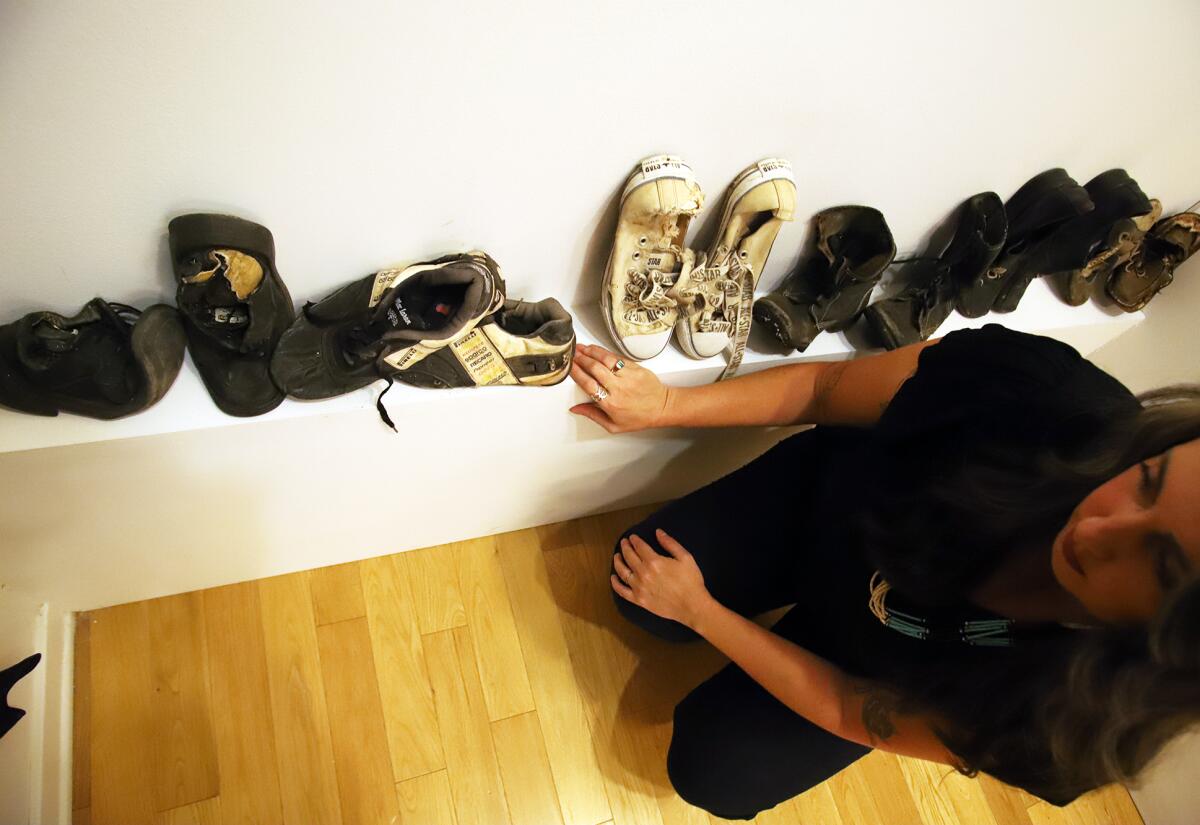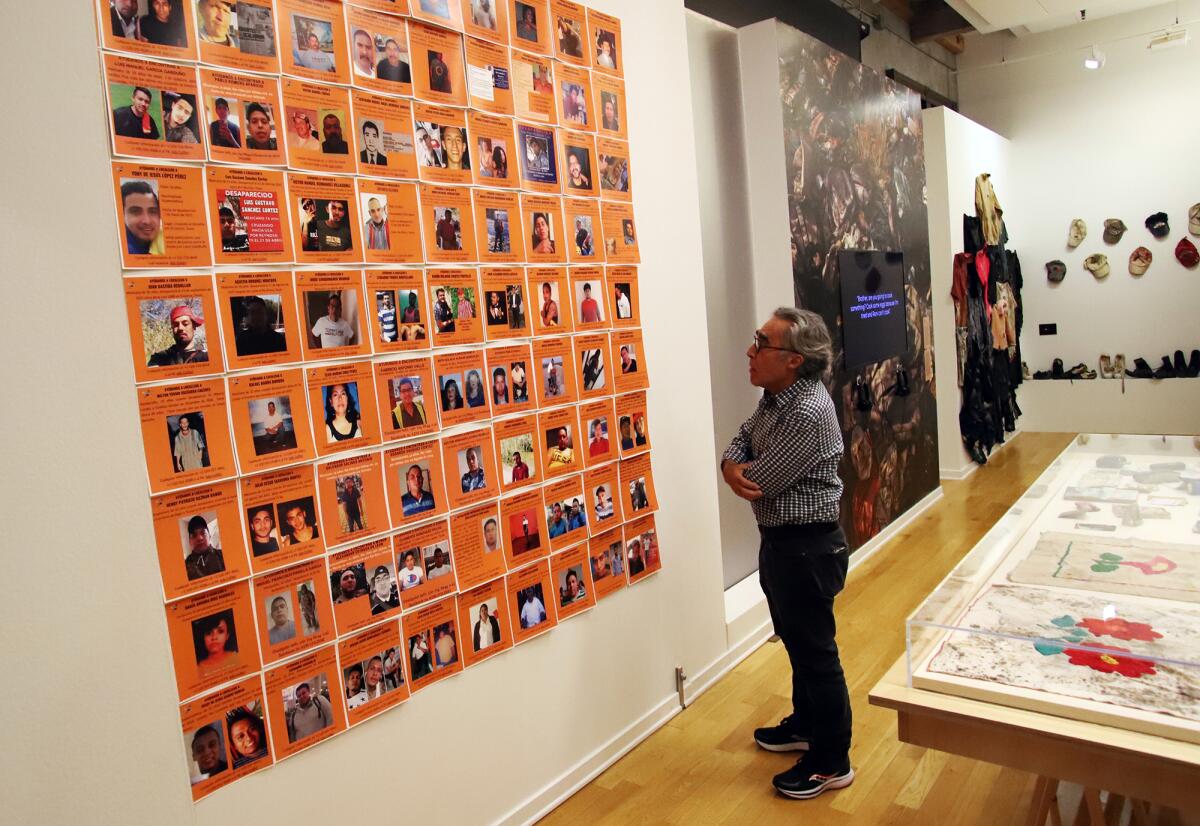U.S.-Mexico border holds tragic immigrant stories. A new L.A. exhibition lets them speak

- Share via
LOS ANGELES — Traveling through the desert along the U.S.-Mexico border, many immigrants know they must be prepared to survive, and even to die.
A water bottle wrapped in a scrap of old clothing to keep it as cold as possible is crucial. Tennis shoes are best for endless trudging along dirt roads, if any roads exist. A broad hat can fend off blistering sunlight and blinding wind.
The pathway is mined with danger: a scorpion’s sting, a snake’s bit, a smuggler’s treachery.
And there, for many, ends the journey. A castaway pair of shoes or a discarded backpack stuffed with personal documents and photos of loved ones may be the only sign that the trek ever took place.

Since the 1990s, nearly 4,000 migrants have died trying to cross Arizona’s Sonoran Desert, and the number is increasing by the day. Knowing the names of some of the dead, and being able to view objects they left behind, can be shocking. But immigrant-rights advocates and academic researchers say it’s essential knowledge for U.S. citizens and the elected officials who make policy — and political opportunism — out of what happens on the border.
At LA Plaza de Cultura y Artes, next to Placita Olvera in downtown Los Angeles, a new exhibition gives voice to many of the migrants who try to cross this adverse terrain. But the curators of “Hostile Terrain ’94: The Undocumented Migration Project” wish they didn’t have to keep revisiting such lethal ground.
The multimedia exhibition, which opened Sept. 17 and will run through July, records the journeys and testimonies of immigrants who try to cross this dangerous stretch, through testimonies, films and photographs, abandoned objects and other materials.
Additionally, a 16-foot wall map of the Arizona-Mexico border is on display, with hanging tags depicting people who died crossing the border between the mid-1990s and 2022. The tags are geolocated to indicate the exact spots where remains were found.
Jason De León, a UCLA anthropologist and executive director of the Undocumented Migration Project and the Colibrí Center for Human Rights, said his ideal would have been to never have to plan such an exhibition. Its existence testifies to an ongoing calamity.
“We are talking about thousands of deaths that have occurred,” said De León, who worked on the exhibition in concert with Michael Wells, a co-curator and photographer; Austin Ella Shipman, assistant director and co-curator; and Perla Torres, family network director of the Colibrí Center for Human Rights. The exhibition is being staged in partnership with the LA Plaza curatorial team led by senior curator Karen Crews Hendon.
“There is a lot of talk about border security and the issue becomes polarized, it becomes political, and yet no one really understands what happens in those places,” De León said.
A crucial turn in U.S. immigration policy occurred in 1994, when the United States Border Patrol formally implemented the immigration enforcement strategy known as “Prevention Through Deterrence.”
Designed to discourage immigrants from attempting to cross the border near urban ports of entry, the policy had the effect of funneling migrants through more remote and dangerous gateways such as the Sonoran Desert, leading to huge increases in the annual death count. Most victims died from dehydration and hypothermia.
“This policy was nothing more than a weapon against migrants,” De León said. “They were not deterred and continue to die.”
De León began in 2009 to make forays into the desert to recover abandoned artifacts that illuminated the social and economic phenomena behind migration. He collected everything, including clothing and tires of Border Patrol vehicles. Some of those artifacts found their way into the exhibition.
Wells said one of the exhibition’s most impressive attributes is its varied content. It includes not only photographs but also video shot by drones of the different hazardous environments that migrants must overcome to reach the United States.
The exhibition also allows visitors to hear migrants’ stories in their own words.
“The goal is to show different angles and perspectives so that there is a complete immersion of the community, since there are those who have only heard of the subject, but do not really know how sad and surprising the visuals and the stories are,” Wells said.
As part of the exhibition, visitors can create tags to pinpoint the location of bodies that have been found this year.
Crews Hendon, of LA Plaza, said the project aims to raise awareness and to offer an opportunity for healing to families who have suffered the painful loss of loved ones due to an inhumane system.
“We are talking about a humanitarian crisis and a political issue that has affected thousands of families. If we don’t see it and we don’t talk about it, there can be no change,” Crews Hendon said.
“Policies and laws can also cause a lot of pain, and as we see here, deaths,” she said. “These deaths could have been prevented.”
“Hostile Terrain ‘94: The Undocumented Migration Project,” at LA Plaza de Cultura y Artes, 501 North Main St., Los Angeles, 90012. The exhibition, on the second floor of the museum, will run until July 9, 2023.
More to Read
Sign up for Essential California
The most important California stories and recommendations in your inbox every morning.
You may occasionally receive promotional content from the Los Angeles Times.













